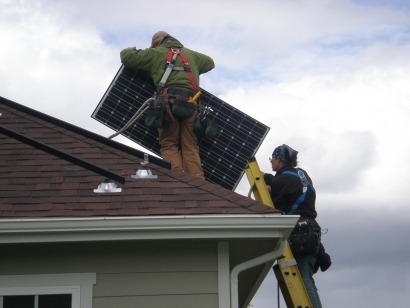
According to Tracking the Sun, an annual PV cost tracking report published by the US Department of Energy (DOE) Lawrence Berkeley National Laboratory (Berkeley Lab), the installed price of solar PV in the US fell significantly in 2012 and continues to fall in the first half of 2013.
Installed prices for PV systems in 2012 fell by a range of roughly $0.30 per Watt (W) to $0.90/W, or 6 to 14 percent, from the prior year, depending on the size of the system. Within the first six months of 2013, prices in California fell by an additional 10 to 15 percent and the report suggests that price reductions in 2013 are on track to match or exceed those seen over recent years.
“This marks the third year in a row of significant price reductions for PV systems in the US” said Galen Barbose of Berkeley Lab’s Environmental Energy Technologies Division, one of the report’s co-authors.
The median installed price of PV systems completed in 2012 was $5.30/W for residential and small commercial systems smaller than 10 kilowatts (kW) in size according to the report, while the price for commercial systems of 100 kW or more in size was $4.60/W. Prices fell even further in 2012 for utility-scale systems with larger than 10,000 kW generally ranging from $2.50/W to $4.00/W. The report additionally records the wide variability in PV system pricing, detailing the installed price differences across states and across various types of PV applications and system configurations.
The report is based on data collected from more than 200,000 residential, commercial and utility-scale PV systems installed between 1998 and 2012 across 29 states, representing roughly 72 percent of all grid-connected PV capacity installed in the US. The aim of the report is to provide policy makers and industry observers with a reliable and detailed set of historical benchmarks for tracking and understanding trends in installed prices for PV.
The market for solar PV has grown rapidly over the past decade and recent installed price reductions for PV systems are primarily attributable to steep reductions in the price of PV modules, the report says. Annual average module prices fell by $2.60/W between 2008 and 2012, representing about 80 percent of the total decline in PV system prices over that period. Non-module costs, such as those for inverters, mounting hardware and various non-hardware or “soft” costs, have also fallen over the long term despite remaining relatively flat in recent years. Further price reductions are likely to be attributable to falling soft costs such as those in marketing, customer acquisition, system design, installation, labour and permitting and inspections.
“Soft costs are especially important from the perspective of public policy efforts” said Galen Barbose. “Unlike module prices, which are established based on global supply and demand, soft costs can be influenced more directly by local, state and national policies aimed at accelerating deployment and removing market barriers.”
The report also compares prices in the US with other major international markets and finds that US prices are generally higher. The differences are particularly marked when comparing US prices with those in Germany, Italy and Australia where prices for small residential systems in 2012 were around 40 percent lower than those in the US. Meanwhile, rebates and incentives for both residential and commercial systems have declined significantly in many regions, falling by around 85 percent over the past decade.
Further information:
Lawrence Berkeley National Laboratory
Download the report here
A webinar presentation of key findings from the report will be conducted on Friday, August 16 at 11:00 am PDT. Register for the webinar here

